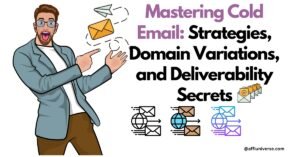In today’s fast-paced digital world, email marketing is one of the most potent ways to connect with your audience. Whether running a small business, managing a marketing team, or launching your startup, bulk email marketing software can transform how you communicate with your customers. But with so many options, how do you pick the right one? This guide will explain everything you need about bulk email marketing software, its advantages, and the top 10 tools to consider in 2025. Let’s dive in!

What Exactly is Bulk Email Marketing Software?
Bulk email marketing software is a platform that helps businesses send large volumes of emails to their subscriers or customers efficiently. These tools come packed with features that make creating, sending, and tracking email campaigns easy. From designing stunning templates to analyzing how well your emails perform, bulk email marketing software handles it all.
Why Should You Care?
- Saves Time: Sending emails one by one is a thing of the past. Bulk email software automates the process, freeing up your time.
- Boosts Efficiency: With features like audience segmentation and personalization, you can send the right message to the right people.
- Increases Engagement: Professional templates and detailed analytics help you craft emails that truly resonate with your audience.
- Cost-Effective: Compared to traditional marketing methods, email marketing delivers a higher return on investment (ROI).
Top 10 Bulk Email Marketing Tools for 2025
Here’s a rundown of the top 10 bulk email marketing tools that are making waves in 2025. We’ll also highlight their standout features to help you decide which one fits your needs.
1. Mailchimp
Mailchimp is a household name in email marketing, especially for beginners. It’s simple to use and loaded with features.Mailchimp is more than just an email tool—it’s a marketing hub. Beyond email campaigns, it offers social media ads, landing pages, and even postcards. Its AI-powered Creative Assistant helps design stunning emails in minutes. Perfect for small businesses, Mailchimp also provides industry-specific templates, making it easy to create professional campaigns without a designer. Its free plan is a great starting point, but its paid plans unlock advanced features like customer journey mapping.

Standout Features:
- Drag-and-drop email builder
- Advanced audience segmentation
- A/B testing for campaigns
- Automation workflows
- In-depth analytics and reporting
2. Constant Contact
Constant Contact is a favorite among small businesses for its ease of use and robust functionality. Constant Contact shines with its event marketing tools, making it ideal for businesses hosting webinars, workshops, or fundraisers. It also offers a unique “Email Plus” feature, combining email marketing with social posting and ads. Its extensive library of how-to resources and 24/7 support makes it a favorite for beginners. Plus, its surveys and polls feature helps you gather feedback directly from your audience.

Standout Features:
- Customizable email templates
- Tools for event marketing
- Social media integration
- Real-time tracking and reporting
- Easy list management
3. Sendinblue – Brevo
Sendinblue is an all-in-one marketing platform that goes beyond email, offering SMS campaigns and more. Sendinblue stands out with its SMS marketing feature, allowing you to reach customers via text and email. Its transactional email support is perfect for e-commerce businesses sending order confirmations or shipping updates. The platform’s unlimited contacts model is a game-changer for growing businesses. Plus, its Facebook Ads integration helps you retarget subscribers seamlessly.
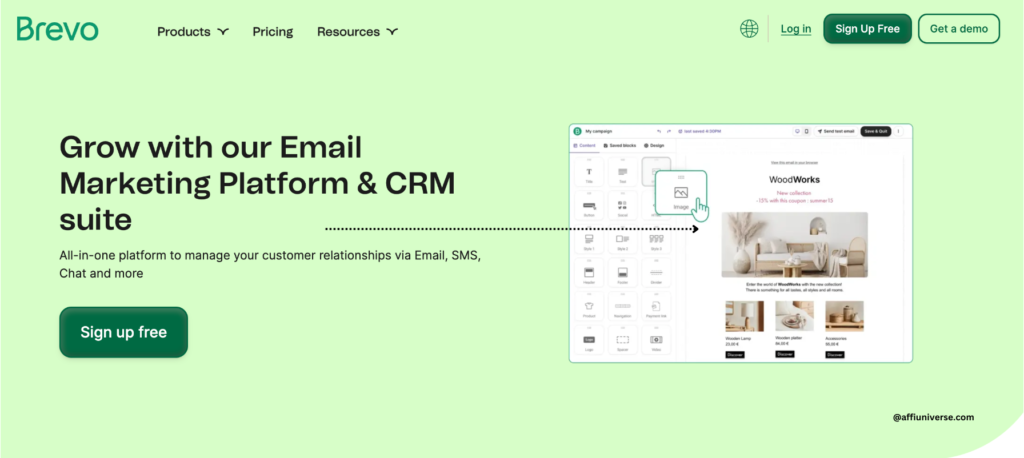
Standout Features:
- Unlimited contacts (you only pay for emails sent)
- Marketing automation
- CRM integration
- Support for transactional emails
- Real-time analytics
4. GetResponse
GetResponse is a versatile tool that works well for both beginners and advanced users. GetResponse is a one-stop shop for marketers, offering not just email tools but also webinar hosting and landing pages. Its AI-powered email generator creates content in seconds, saving you time. The platform’s conversion funnel feature helps you turn subscribers into customers. It’s ideal for businesses looking to combine email marketing with lead generation and sales automation.
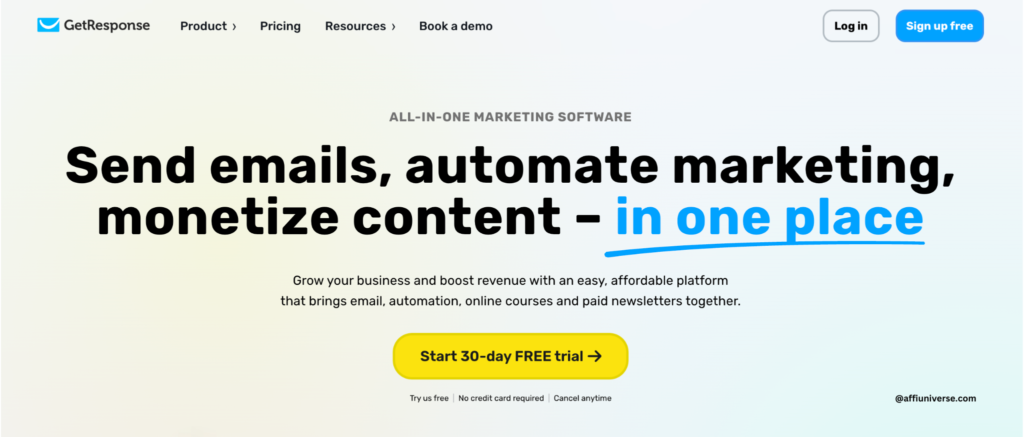
Standout Features:
- Autoresponders and automation
- Landing page builder
- Webinar hosting
- Advanced analytics
- AI-powered email design
5. AWeber
AWeber is a reliable choice for businesses looking for a no-fuss email marketing solution. AWeber is a veteran in the email marketing space, trusted by over 1 million users. Its standout feature is its extensive library of pre-built templates and automation workflows. It also offers a unique “Curated Content” feature, which suggests relevant articles to share with your subscribers. AWeber’s focus on simplicity and reliability makes it a go-to for solopreneurs and small teams.
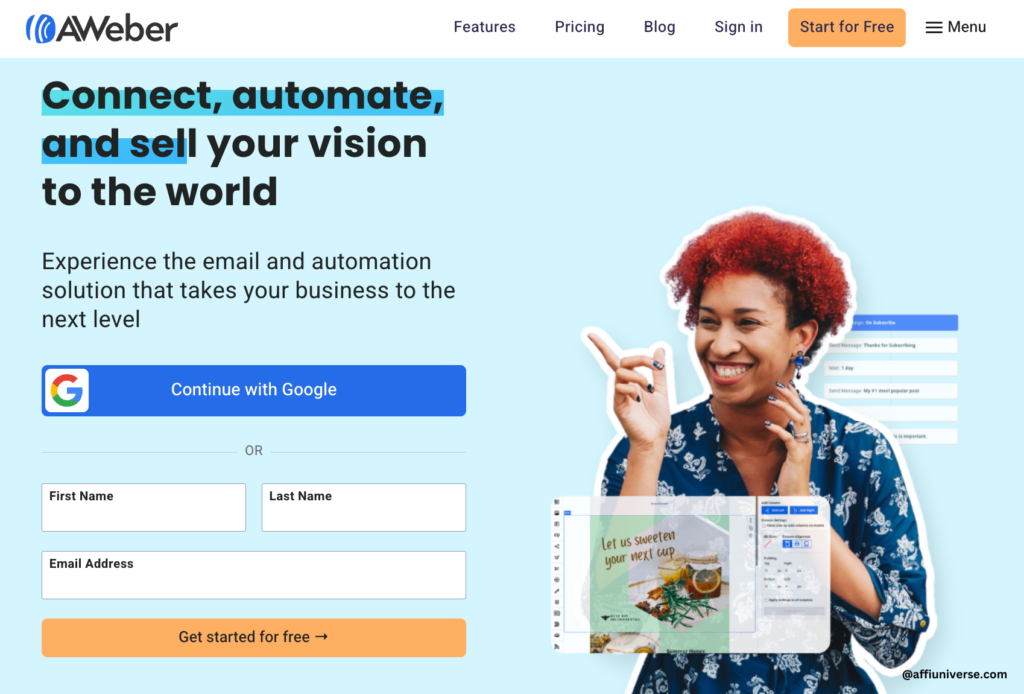
Standout Features:
- Pre-designed email templates
- Automated email sequences
- Subscriber segmentation
- Analytics and tracking
- Integrations with popular tools
6. HubSpot Email Marketing
HubSpot is a powerhouse for inbound marketing, and its email marketing tool is no exception. HubSpot’s email tool is part of its powerful CRM ecosystem, making it perfect for businesses focused on inbound marketing. Its personalization tokens let you tailor emails to individual subscribers, while its predictive sending feature ensures emails are delivered at the optimal time. HubSpot also offers robust analytics, helping you track ROI and campaign performance in real-time.

Standout Features:
- Drag-and-drop editor
- Personalization tokens
- CRM integration
- Advanced analytics
- A/B testing
7. ActiveCampaign
ActiveCampaign is known for its advanced automation features, making it ideal for businesses with complex workflows. ActiveCampaign is the king of automation, offering over 500 pre-built automation recipes. Its machine learning feature predicts the best times to send emails and even suggests subject lines. The platform’s site tracking feature lets you monitor subscriber behavior, enabling hyper-targeted campaigns. It’s ideal for businesses with complex sales funnels.

Standout Features:
- Visual automation builder
- CRM and sales automation
- Site and event tracking
- Split testing
- Predictive sending
8. Moosend
Moosend is a budget-friendly option that doesn’t skimp on features. Moosend is a hidden gem, offering enterprise-level features at an affordable price. Its standout feature is its real-time analytics dashboard, which provides instant insights into campaign performance. Moosend also offers a unique “Product Recommendations” feature for e-commerce businesses, helping you upsell and cross-sell products directly in your emails.

Standout Features:
- Drag-and-drop editor
- Real-time analytics
- Automation workflows
- Landing page builder
- A/B testing
9. Campaign Monitor
Campaign Monitor is perfect for businesses that value design and aesthetics. Campaign Monitor is all about design. Its drag-and-drop builder is incredibly intuitive, and its templates are visually stunning. The platform also offers a unique “Send Time Optimization” feature, which automatically sends emails when your subscribers are most likely to open them. It’s perfect for creative businesses that want their emails to stand out.
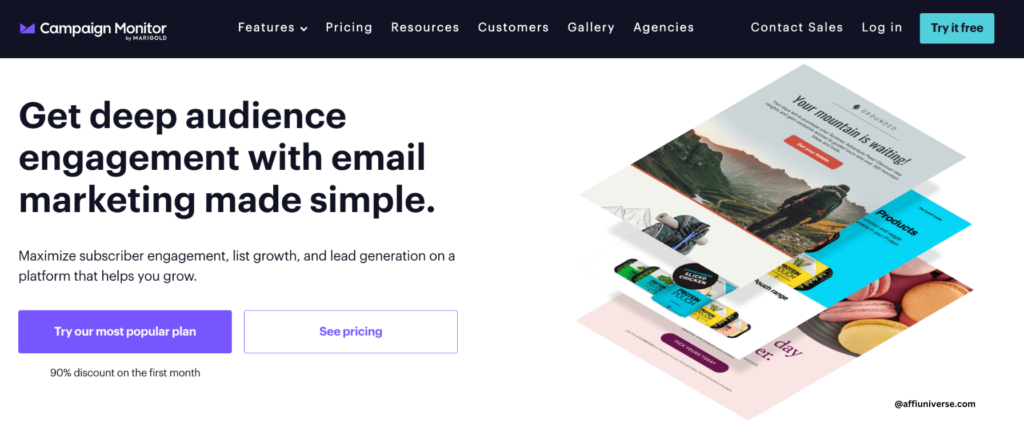
Standout Features:
- Beautiful email templates
- Drag-and-drop builder
- Personalization options
- Analytics and reporting
- Integrations with popular platforms
10. MailerLite
MailerLite is a cost-effective solution that delivers powerful features without breaking the bank. MailerLite is a budget-friendly powerhouse, offering features like pop-ups, landing pages, and even a website builder. Its standout feature is its simplicity—everything from the interface to the automation workflows is easy to use. MailerLite also offers a unique “RSS Campaigns” feature, which automatically sends emails when you publish new blog content. It’s ideal for bloggers and content creators.
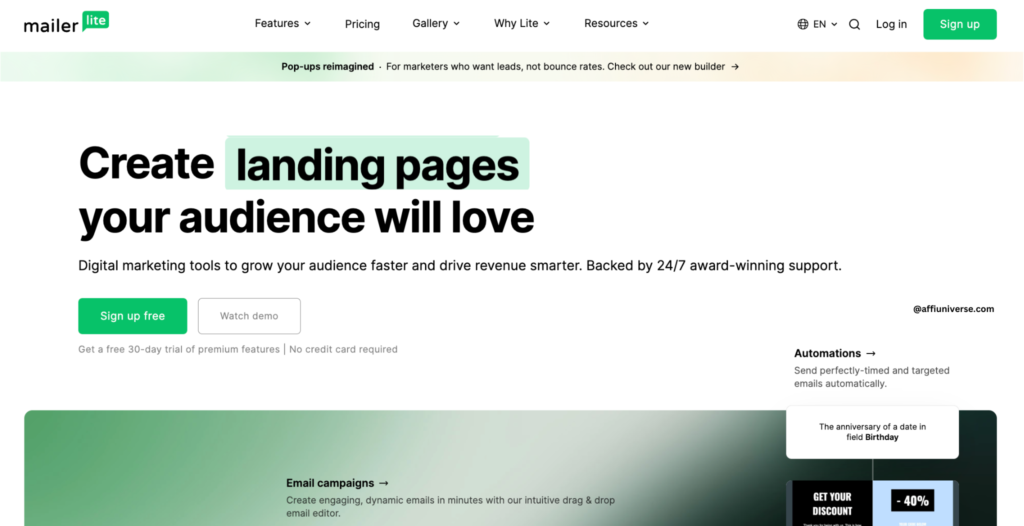
Standout Features:
- Drag-and-drop editor
- Automation workflows
- Landing pages and pop-ups
- Subscriber segmentation
- Real-time analytics
How to Pick the Right Bulk Email Marketing Software
With so many options available, choosing the right tool can feel overwhelming. Here are some factors to keep in mind:
1. Ease of Use
If you’re new to email marketing, look for a platform with an intuitive interface and drag-and-drop functionality.
2. Automation Features
Automation saves time and ensures your emails are sent at the right moment. Check if the software offers workflows that match your needs.
3. Templates and Design
Eye-catching emails can boost engagement. Choose a tool with customizable templates that align with your brand.
4. Analytics and Reporting
Tracking your campaign’s performance is crucial. Opt for software that provides detailed insights.
5. Pricing
Compare pricing plans to find one that fits your budget. Some platforms charge based on the number of subscribers, while others charge per email sent.
6. Integration
Make sure the software integrates seamlessly with your existing tools, such as CRM systems, e-commerce platforms, or social media.
Why Bulk Email Marketing Software is a Game-Changer
1. Reach More People
With bulk email software, you can send emails to thousands of recipients at once, expanding your reach effortlessly.
2. Personalize Your Messages
Most tools let you personalize emails with the recipient’s name, location, or other details, making your messages more engaging.
3. Automate Your Campaigns
Set up automated workflows to send welcome emails, follow-ups, or reminders without lifting a finger.
4. Track Your Success
Monitor metrics like open rates, click-through rates, and conversions to understand what’s working and what’s not.
5. Save Money
Email marketing is one of the most affordable ways to promote your business, and bulk email software makes it even more efficient.
Common Mistakes to Avoid in Bulk Email Marketing
While bulk email marketing is incredibly effective, it’s easy to make mistakes that can hurt your campaign’s success. Here are some pitfalls to watch out for:
1. Not Segmenting Your Audience
Sending the same email to everyone can lead to low engagement. Segment your list based on demographics, behavior, or preferences.
2. Ignoring Mobile Users
Most people check emails on their phones. Make sure your emails are mobile-friendly.
3. Overloading with Information
Keep your emails concise and to the point. Too much text can overwhelm readers.
4. Forgetting the Subject Line
Your subject line is the first thing recipients see. Make it catchy and relevant.
5. Skipping the Test Run
Always test your emails before sending them to ensure they look great and function properly.
Final Thoughts
Bulk email marketing software is a must-have tool for businesses to streamline email campaigns and achieve better results. From saving time to boosting engagement, the benefits are hard to ignore. Choosing the right software and avoiding common mistakes can take your email marketing to new heights.
Whether you’re just starting or you’re a seasoned pro, the tools listed above offer something for everyone. Take the time to explore their features and find the one that aligns with your goals. Remember, delivering value to your audience is key to successful email marketing.
If you’re interested in making a career out of email marketing, plenty of email marketing jobs are available, ranging from campaign managers to automation specialists. As more businesses rely on digital outreach, skilled professionals in this field are in high demand. Learning how to use bulk email marketing software effectively can be a great stepping stone toward landing a rewarding role in the industry.
So, what are you waiting for? Start exploring these bulk email marketing tools today and watch your campaigns thrive!
FAQs About Bulk Email Marketing Software
1. What’s the best bulk email marketing software for beginners?
Mailchimp and Constant Contact are excellent choices for beginners because of their user-friendly interfaces.
2. Can I send bulk emails for free?
Yes, some platforms like MailerLite and Sendinblue offer free plans with limited features.
3. How can I avoid my emails ending up in spam folders?
Use a reputable email marketing tool, avoid spammy language, and ensure your recipients have opted in.
4. How much does bulk email marketing software cost?
Costs vary depending on the platform and the number of subscribers. Most tools start at around 10–10–20 per month.
5. Can I automate my email campaigns?
Absolutely! Most bulk email marketing tools offer automation features to schedule and send emails automatically.
By following this guide, you’ll be well-equipped to choose the best bulk email marketing software for your needs. Happy emailing!




